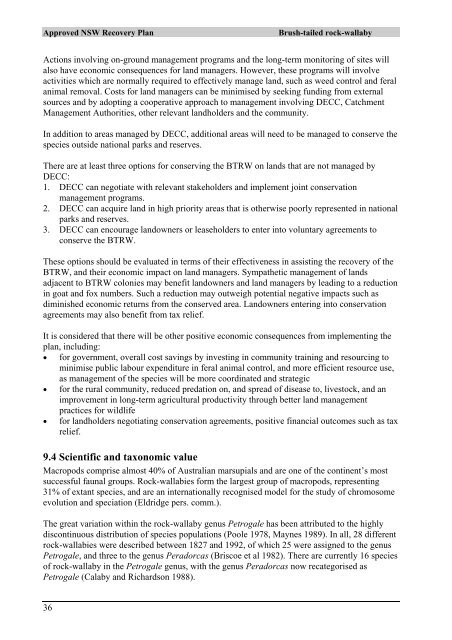Recovery plan for the brush-tailed rock-wallaby - Department of ...
Recovery plan for the brush-tailed rock-wallaby - Department of ...
Recovery plan for the brush-tailed rock-wallaby - Department of ...
You also want an ePaper? Increase the reach of your titles
YUMPU automatically turns print PDFs into web optimized ePapers that Google loves.
Approved NSW <strong>Recovery</strong> Plan Brush-<strong>tailed</strong> <strong>rock</strong>-<strong>wallaby</strong><br />
Actions involving on-ground management programs and <strong>the</strong> long-term monitoring <strong>of</strong> sites will<br />
also have economic consequences <strong>for</strong> land managers. However, <strong>the</strong>se programs will involve<br />
activities which are normally required to effectively manage land, such as weed control and feral<br />
animal removal. Costs <strong>for</strong> land managers can be minimised by seeking funding from external<br />
sources and by adopting a cooperative approach to management involving DECC, Catchment<br />
Management Authorities, o<strong>the</strong>r relevant landholders and <strong>the</strong> community.<br />
In addition to areas managed by DECC, additional areas will need to be managed to conserve <strong>the</strong><br />
species outside national parks and reserves.<br />
There are at least three options <strong>for</strong> conserving <strong>the</strong> BTRW on lands that are not managed by<br />
DECC:<br />
1. DECC can negotiate with relevant stakeholders and implement joint conservation<br />
management programs.<br />
2. DECC can acquire land in high priority areas that is o<strong>the</strong>rwise poorly represented in national<br />
parks and reserves.<br />
3. DECC can encourage landowners or leaseholders to enter into voluntary agreements to<br />
conserve <strong>the</strong> BTRW.<br />
These options should be evaluated in terms <strong>of</strong> <strong>the</strong>ir effectiveness in assisting <strong>the</strong> recovery <strong>of</strong> <strong>the</strong><br />
BTRW, and <strong>the</strong>ir economic impact on land managers. Sympa<strong>the</strong>tic management <strong>of</strong> lands<br />
adjacent to BTRW colonies may benefit landowners and land managers by leading to a reduction<br />
in goat and fox numbers. Such a reduction may outweigh potential negative impacts such as<br />
diminished economic returns from <strong>the</strong> conserved area. Landowners entering into conservation<br />
agreements may also benefit from tax relief.<br />
It is considered that <strong>the</strong>re will be o<strong>the</strong>r positive economic consequences from implementing <strong>the</strong><br />
<strong>plan</strong>, including:<br />
• <strong>for</strong> government, overall cost savings by investing in community training and resourcing to<br />
minimise public labour expenditure in feral animal control, and more efficient resource use,<br />
as management <strong>of</strong> <strong>the</strong> species will be more coordinated and strategic<br />
• <strong>for</strong> <strong>the</strong> rural community, reduced predation on, and spread <strong>of</strong> disease to, livestock, and an<br />
improvement in long-term agricultural productivity through better land management<br />
practices <strong>for</strong> wildlife<br />
• <strong>for</strong> landholders negotiating conservation agreements, positive financial outcomes such as tax<br />
relief.<br />
9.4 Scientific and taxonomic value<br />
Macropods comprise almost 40% <strong>of</strong> Australian marsupials and are one <strong>of</strong> <strong>the</strong> continent’s most<br />
successful faunal groups. Rock-wallabies <strong>for</strong>m <strong>the</strong> largest group <strong>of</strong> macropods, representing<br />
31% <strong>of</strong> extant species, and are an internationally recognised model <strong>for</strong> <strong>the</strong> study <strong>of</strong> chromosome<br />
evolution and speciation (Eldridge pers. comm.).<br />
The great variation within <strong>the</strong> <strong>rock</strong>-<strong>wallaby</strong> genus Petrogale has been attributed to <strong>the</strong> highly<br />
discontinuous distribution <strong>of</strong> species populations (Poole 1978, Maynes 1989). In all, 28 different<br />
<strong>rock</strong>-wallabies were described between 1827 and 1992, <strong>of</strong> which 25 were assigned to <strong>the</strong> genus<br />
Petrogale, and three to <strong>the</strong> genus Peradorcas (Briscoe et al 1982). There are currently 16 species<br />
<strong>of</strong> <strong>rock</strong>-<strong>wallaby</strong> in <strong>the</strong> Petrogale genus, with <strong>the</strong> genus Peradorcas now recategorised as<br />
Petrogale (Calaby and Richardson 1988).<br />
36

















